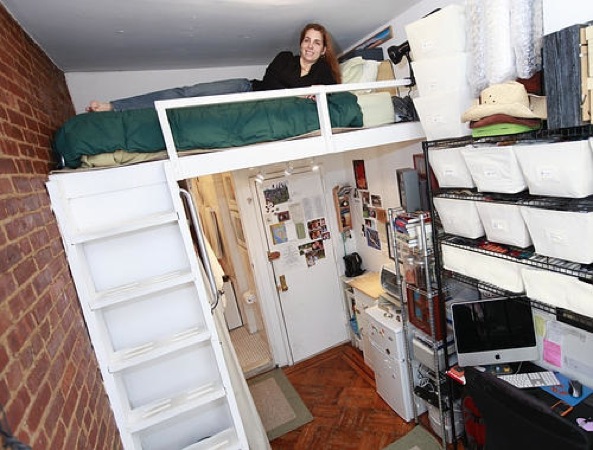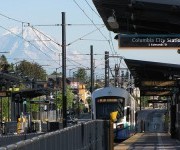A light rail line is part of the new development reshaping South Seattle. Check Mt. Rainier looming in the background.Photo: Wendi DunlapA few years ago, a rumor started flying around that my zip code — 98118 in Seattle — is the most diverse in the nation. Local media outlets quickly reported the story as fact, only to backpedal after checking in with the Census Bureau, which denied having the ability to make such qualitative declarations (what special combination of statistics would make one zip code more “diverse” than every other, anyway?). So now those of us in the 98118, which encompasses several smaller neighborhoods but is part of what Seattleites generally refer to as the city’s South End, like to say we live in one of the most diverse zip codes in the country.
The area definitely deviates from this city’s norm of pasty, plaid-clad rockers, affluent ex-hippies, and reticent descendants of Scandinavian fishermen. We have those stereotypes in the South End, too, but the numbers speak for themselves: Seattle overall is 70 percent white, while in the 98118 zip code, no race can claim a majority — 31 percent of residents are white, 26 percent are black, 33 percent are Asian, and the rest are Latino, American Indian, mixed race, or “some other race,” as the Census puts it in its 2010 report. As of the 2000 Census, a third were not born in the U.S., and 43 percent speak a language other than English at home. The diversity is economic, too: Walk a mile or two in the 98118 and you’ll stumble across multimillion dollar lakefront homes, fixer-upper bungalows, modest postwar ramblers, brand-spankin’ new condos, and shabby, low-rent apartment complexes — sometimes all within a few blocks of each other.
The area’s white population increased from 27 to 31 percent between the 2000 and 2010 censuses, and any citizen of the 98118 will tell you that the neighborhood’s changed a lot over the last decade. It’s been changing since my parents moved there, in 1990, when they realized that the South End’s affordability conveniently coincided with their desire to raise their children outside the cloying whiteness of North Seattle. But it was in our family’s second decade in the area that the effects of gentrification began to float more visibly to the surface. Columbia City, the slightly denser, more commercial neighborhood just west of sleepy Seward Park, where I live, wore the face of these changes, as the lackluster business strip there transformed into a bustling urban hub, complete with gift boutiques, a farmers market, a yoga studio, a bookstore, a cinema (now defunct, unfortunately — it was the only one in all of South Seattle), and drinking and dining options both fine and casual. Over the same period, the city razed two public housing projects in the 98118 to make way for mixed-income developments, and chose Martin Luther King, Jr. Way South, a major neighborhood arterial, as the route for the new light rail line that opened in 2009. Not surprisingly, all the new development has spurred a rise in property values, and celebrations of the neighborhood’s renewal walk hand-in-hand with fears that it will lose its unique character if lower-income residents are pushed out.
Seattle Mayor Mike McGinn (in black shirt) mingles with 98118 residents at a cultural parade.Photo: Rainier Valley Post
It’s a textbook case of gentrification, a term educated liberals like to throw around to demonstrate that they care about the plight of the urban poor, while often, I think, having little understanding of what it really means beyond the sociology classroom. What gets lost in debates about neighborhoods like mine is the reason the gentrification machine gets set in motion in the first place: Some people value diversity enough to break out of their race- and class-stratified cocoons and seek it out. And isn’t that an inherently great thing, a healthy instinct that should be encouraged in all neighborhoods of all cities? We all know that ignorance breeds intolerance, and nothing combats ignorance like face-to-face interaction with the unknown. My parents and their white peers did not move to the 98118 rubbing their hands together and cackling, “Just wait til we drive property values up and minorities out!” Exactly the opposite — they settled here because they wanted my brother and me to have a different childhood experience than theirs. (My mom grew up in a status-conscious neighborhood in the North End, my dad in a rural redneck exurb.) They wanted us to grow up seeing people who looked different from us and hearing foreign languages (59 are said to be spoken in the 98118) on a daily basis.
Which isn’t to say that being white and living in the South End is just some fun social experiment, either — another accusation that gets lobbed around in debates about gentrification. As Charles Mudede, a writer for local weekly The Stranger, put it in a recent feature about Columbia City: “The process is also about middle-class white people who have not seen their real income increase since the 1970s and have only homeownership as a way to make any real gains. To go into these poor and long-neglected neighborhoods, to take the risk, to improve the streets and economy, this is practically the only chance they have of making real money.” Median home prices in the 98118 are lower than elsewhere in the city; many white transplants to the South End simply wanted more bang for their buck, housing-wise, and the neighborhood’s vibrant character came as an unforeseen added benefit.
A block party in the neighborhood.Photo: Rainier Valley Post
I, for one, feel incredibly lucky to live in this unique zip code. After spending four years at one of the 10 least economically diverse colleges in the country, I’ve come to appreciate how much growing up in the 98118 shaped me. Yes, the demographics are shifting, but when I run in Seward Park, the 277-acre forested peninsula jutting into Lake Washington for which my neighborhood is named, I still feel like I live in one of the most diverse zip codes in the country. Go to the park on a sunny summer Sunday, and you really will see families of every ethnicity, nationality, and religious affiliation (90 percent of Seattle’s Orthodox Jewish community lives in the 98118, by the way), headed by parents of every sexual orientation, speaking more languages than you could recognize or count, doing what families do: picnicking, swimming, teaching their kids to
play soccer and share and ride bikes. Maybe you’ll catch a glimpse of the pair of nesting bald eagles that lives in the park, too. Kumbaya, for real.
But for all my kumbaya moments in the 98118, there are many others in which I wonder, as did John Hoole in a neighborhood blog post:
Where do the interests of Vietnamese refugees, middle-class white homeowners, the well-to-do by the water, new-to-the-neighborhood renters, and African American families who have been in the Valley for generations converge? There always lurks the depressing possibility that they don’t, that compared with all the other things that make us who we are and bind us to others, geography is circumstantial.
Living in such a diverse and volatile area is complicated and not always comfortable. But that’s exactly the point. It’s challenging in the way living in a suburb, or a homogeneous city neighborhood, isn’t. I think a key part of developing tolerance, openness, and understanding is putting those qualities to the test. Seattle, like many cities, is full of ultra-PC white liberals who pat themselves on the back for embracing such values, but live in neighborhoods full of other ultra-PC white liberals, which makes it easy to ignore the large areas of the city where people aren’t as privileged, and crunchy ideals of diversity don’t always play out harmoniously and without conflict. They don’t want to let the sometimes-uncomfortable byproducts of integration into their backyards.
Ethnic businesses, longtime pillars of the area, have sometimes struggled to weather the changes.Photo: Vladimir Menkov
That’s a mistake, because if we’re going to talk about creating sustainable, livable cities, diversity needs to be an essential part of that. It doesn’t just make us feel better about ourselves — it also leads to better policy (and could make cities safer). If cities remain self-segregated into isolated, homogeneous neighborhoods, then a policy decision that affects only one neighborhood also affects only a certain kind of people, and it’s easier for everyone else not to care. Living around people who are not exactly like you makes you appreciate both how healthy diversity is, and how difficult it can be for it to flourish gracefully.
It makes you think, for example, that maybe even though you love the microbrews on tap at the local ale house, some of your neighbors probably think $6 for a beer is bullsh*t and are pissed that Angie’s, the perpetually rowdy dive across the street, closed down. It makes you wonder what it means that a certain bus route can be deemed the most dangerous in the city when riding it is such a comforting routine for you. It makes me regret, sometimes, having attended public magnet schools a few miles north instead of the poorer-performing ones close by. Because two decades in a zip code like the 98118 has made me realize that one of the best ways to avoid the problems of gentrification is for a neighborhood’s newcomers to invest their resources and energy in its existing infrastructures, instead of totally making and taking them over — to send their kids to local public schools, which are starved for parental involvement; to patronize the Ethiopian restaurant and the Vietnamese nail salon and the Mexican taco trucks as well as the new foodie cafes; to ride public transportation alongside their neighbors; to send the message that they want to be part of the community that’s already there. If we had to do it all over again, there are definitely some things my family and I would do differently, but I don’t think any of us would choose to settle somewhere else. A neighborhood like mine imprints its residents with an indelible, sometimes irrational, sense of loyalty.
Most of all, being a white person in a diverse area, and thus supposedly “part of the problem” of gentrification, makes me agonize over how a zip code like the 98118 can remain vibrantly multicultural and undergo renewal without spawning resentment and hostility and upheaval of the bad kind. It’s a question we have to answer if we want to make cities great places to live.



